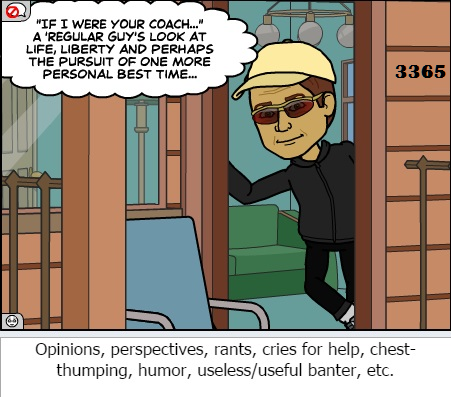
'Hey, I'm in the middle of a race right now & listening to music. Can I call you back later?'
Later that afternoon, our friends Betsy & Aaron invited us over to watch Thanksgiving Day football games, eat a light dinner & catch up on what has happened in the three months since our last visit. Betsy asked how we fared on our drive along Interstate 10; her son "Speedy" recently made his first drive on I-10 without knowing to B.Y.O.B. - Bring Your Own Boogie. The stretch of interstate between Mobile & Slidell can be entertaining & mind-numbing. My first trip eight years ago proved compact discs & MP3 players are necessary to maintain driver sanity. However, the youngster has not yet acquiesced to his parents' taste in music. Betsy said "Speedy" called during the drive on his iPhone, complaining about the dearth of entertainment on the airwaves.
You live; you learn, youngster.
Many persons complain about the need to get away from it all. What surprises me more is when the very same people bring it all (and I do mean 'all') with them by way of their smart phones & music players.
I do not completely disagree with them. The smart phone, nowadays, can be the next best thing to a training partner who knows where to go, what to see, & how to get back to where you left the car when it's all said & done. Don't forget the ability to take photographic & videographic proof of where you've been so as to make friends who decided to sleep in or stay home green-eyed with jealousy. There are hazards involved with listening to music on the run which have mostly to do with volume & situational awareness. But, I wear them in the gym for treadmill work & solo long runs because they keep me from thinking about the pain I'm inflicting on my body. I know the risks of my immediate environment & keep my jams down to a low roar.
On race day, however, I leave them in the car. Having your favorite tunes in your ears from start to finish of a race is one thing, but the multitasking thing - listening to music, checking electronic mail, taking phone calls & texting your friends - is best left for the office. The race course - and the jogging path - is the place to get away from the world's stressors, not to catch up with them because you have 50-to-60 minutes to spare. Because, really, many of us don't do even one thing all that well.
My wife thinks she does a great job at multitasking. I keep telling her she is not among the two percent of what psychologists call "supertaskers," those who are truly able to accomplish two tasks simultaneously with nearly the same level of quality. I'm willing to admit she's able to switch between some tasks in a rapid manner, which is what most people mistakenly identify as multitasking. However, there are unlatched doors, half-screwed-on lids, lost & subsequently replaced identification & credit cards which bear witness to her - and many people's - low threshhold of task switchability.
Once again, an honest admission: My level of task switchability is very low. I've tried to justify it on the grounds of visual impairment, but it's my lack of ability to pick out my wife from a large crowd before or after a race. Any of my running friends will tell you my most common post-race question is not "how did I do?" Most often it's "have you seen my wife?" The executive system in the frontal lobe of my brain, most often, is looking for a strawberry blonde woman in a blue sweat top. Darned if she didn't ditch her sweat top in the car & put on a white hat.
So for me, task juggling is absolutely out. When I train my mind is on the training. When I race my mind is on the race. If I decide to look for my wife before the start, like this last week, odds are good I'm going to be stuck back in the back of the pack. Behind the joggers. Behind the walkers. And behind the multitaskers who decided their wife couldn't cook the turkey without their help via cellular phone.
That should teach me to not worry about my wife's whereabouts until it's time to go home. Besides, I know she'll be close to the beer truck.











